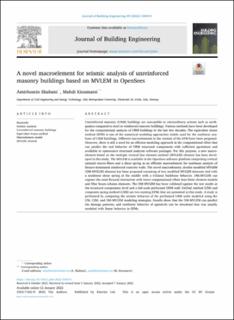| dc.contributor.author | Shabani, Amirhosein | |
| dc.contributor.author | Kioumarsi, Mahdi | |
| dc.date.accessioned | 2022-03-01T13:32:19Z | |
| dc.date.available | 2022-03-01T13:32:19Z | |
| dc.date.created | 2022-01-20T19:17:02Z | |
| dc.date.issued | 2022-01-16 | |
| dc.identifier.citation | Journal of Building Engineering. 2022, 49 . | en_US |
| dc.identifier.issn | 2352-7102 | |
| dc.identifier.uri | https://hdl.handle.net/11250/2982135 | |
| dc.description.abstract | Unreinforced masonry (URM) buildings are susceptible to extraordinary actions such as earthquakes compared to steel or reinforced concrete buildings. Various methods have been developed for the computational analysis of URM buildings in the last few decades. The equivalent frame method (EFM) is one of the numerical modeling approaches widely used for the nonlinear analyses of URM buildings. Different macroelements in the context of the EFM have been proposed. However, there is still a need for an efficient modeling approach in the computational effort that can predict the real behavior of URM structural components with sufficient agreement and available in opensource structural analyses software packages. For this purpose, a new macro-element based on the multiple vertical line element method (MVLEM) element has been developed in this study. The MVLEM is available in the OpenSees software platform comprising vertical uniaxial macro-fibers and a shear spring as an efficient macroelement for nonlinear analysis of flexure-dominated reinforced concrete walls. The novel macroelement, double modified MVLEM (DM-MVELM) element has been proposed consisting of two modified MVLEM elements tied with a nonlinear shear spring at the middle with a trilinear backbone behavior. DM-MVLEM can capture the axial-flexural interaction with lower computational effort than finite element models and fiber beam-column elements. The DM-MVLEM has been validated against the test results at the structural components level and a full-scale perforated URM wall. Unified method (UM) and composite spring method (CSM) are two existing EFMs that are presented in this study. A study is performed by comparing the seismic behavior of the perforated URM walls modeled using the UM, CSM, and DM-MVLEM modeling strategies. Results show that the DM-MVLEM can predict the damage patterns, and nonlinear behavior of spandrels can be simulated that was usually modeled with linear behavior in EFMs. | en_US |
| dc.description.sponsorship | This work is a part of the HYPERION project. HYPERION has received funding from the European Union’s Framework Programme
for Research and Innovation (Horizon 2020) under grant agreement No 821054. | en_US |
| dc.language.iso | eng | en_US |
| dc.publisher | Elsevier | en_US |
| dc.relation.ispartofseries | Journal of Building Engineering;Volume 49, 15 May 2022, 104019 | |
| dc.rights | Navngivelse 4.0 Internasjonal | * |
| dc.rights.uri | http://creativecommons.org/licenses/by/4.0/deed.no | * |
| dc.subject | Seismic analyses | en_US |
| dc.subject | Unreinforced masonry buildings | en_US |
| dc.subject | Equivalent frame methods | en_US |
| dc.subject | Macroelement models | en_US |
| dc.subject | MVLEM elements | en_US |
| dc.title | A novel macroelement for seismic analysis of unreinforced masonry buildings based on MVLEM in OpenSees | en_US |
| dc.type | Peer reviewed | en_US |
| dc.type | Journal article | en_US |
| dc.description.version | publishedVersion | en_US |
| dc.rights.holder | © 2022 The Authors | en_US |
| dc.source.articlenumber | 104019 | en_US |
| cristin.ispublished | true | |
| cristin.fulltext | original | |
| cristin.qualitycode | 1 | |
| dc.identifier.doi | https://doi.org/10.1016/j.jobe.2022.104019 | |
| dc.identifier.cristin | 1986768 | |
| dc.source.journal | Journal of Building Engineering | en_US |
| dc.source.volume | 49 | en_US |
| dc.source.pagenumber | 1-19 | en_US |
| dc.relation.project | Horisont 2020: EC/H2020/821054 | en_US |

